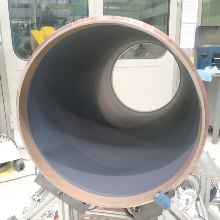In the framework of the international research project ITER (International Thermonuclear Experimental Reactor) the largest fusion reactor is currently erected in South France. ITER is by far the most ambitious international major project, with the aim to utilize fusion energy to solve our worldwide energy problems. If successful , it could provide unlimited and CO2 neutral energy for hundreds of years.
In order to run the research fusion reactor, a powerful microwave heating (170 GHz, ECRH-systems) is required. To produce the microwave radiation, so-called gyrotrons are employed as radiation sources, able to produce focused microwave radiation with energies going up to24 MW. For testing and running-in purposes of these gyrotrons, special absorbers are needed, which are able to absorb the radiation (so-called load targets). To avoid a local thermal overheating, it is useful to distribute the radiation absorption to a possibly large area. This is achieved by a step-wise absorption in combination with multiple reflexion of the microwave radiation.
Since many years, the IFKB deals with the development of absorber for application in fusion reactors. Recently, such microwave absorber coatings have been applied to the inner surface of a 1,3 m long and 180 kg heavy collector tube by the IFKB in cooperation with the KIT in Karlsruhe. The tube has been manufactured of centrifugal casted copper alloy. The coatings have been applied by atmospheric plasma spraying (APS). One of the challenges that had to be solved consist in a varying coating thickness as a function of the tube length. The coating thickness thereby controls the amount of absorbed radiation energy along the inner tube area.
In our institute the complete component manipulation by means of a specially designed component support has been developed and assembled. The coating process is performed into the rotating tube. With the help of a specific robot-guided torch kinematic, it is possible to vary the coating thickness along the tube length.
Your contact person

Andreas Killinger
apl. Prof. Dr. rer. nat.Assistant Director of the Institute
Head of surface technologies and composites group





